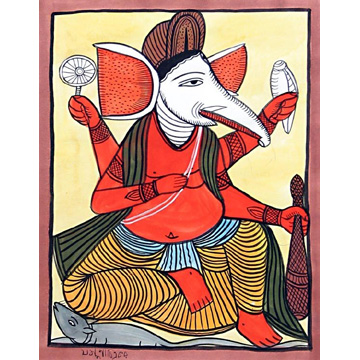 With
With only a couple of practitioners left today, the bold brush strokes and symphony of natural colours that are the hallmark of the 19th century Kalighat paintings from West Bengal are in "urgent" need of a digital boost to breathe fresh life into them, believe art historians and experts.
Kalighat paintings or Kalighat pat refer to the class of water colour paintings on hand-made paper produced by a group of artists called 'Patuas' in the neighbourhood of the famous Kali temple at Kalighat (in south Kolkata) between the 19th and earlier 20th century.
According to Anjan Sen, a Tagore research scholar who is currently trying to offer some clarity into the murky origins of the art form, the genre is "dead".
"Only one or two painters still continue painting such pats. We have to go for digitisation big time. Whatever examples we have today need to be preserved through modern technology," Sen told IANS on the sidelines of a discussion on the famed modern Indian school of art at the Victoria Memorial Hall (VMH) here.
The VMH has around 30 such paintings which are all digitised.
Recently, University of Oxford's Bodleian Libraries posted digital versions of 110 Kalighat paintings of Hindu deities and others on a new online portal so that it can be used by teachers and researchers across the globe.
The Victoria and Albert Museum, London, holds the single largest collection of Kalighat paintings in the world. The collection, which numbers about 645 watercolour drawings and paintings, also includes line drawings and hand-coloured lithographs.
Among the deities that the Kalighat artists painted for the pilgrims and tourists, the goddess Kali was a favourite. Images of Durga, Lakshmi and Annapurna were also popular, especially during the Durga Puja festival. The artists also portrayed themes like Sita-Rama, Radha-Krishna and the exploits of Hanuman.
Another theme depicted was that of Chaitanya Mahaprabhu and his disciples. Capturing daily life was also an important tenet.
There were satirical depictions mocking the hypocrisies of the rich and aristocrats as well as watercolours on changing roles of men and women after the introduction of education for women.
Sen said the art form gradually dwindled after the 1930s due to competition from oleographs and lithographs.
The Kalighat paintings are different from the more common scroll paintings of rural Bengal, said the scholar. They stand out with their colourless background while the scroll paintings or 'patachitra' have a vibrant backdrop.
Bhaskar Chitrokar, a fifth-generation Kalighat pat artist, is one of the few who have refused to throw in the towel, but instead innovate.
For example, natural dyes have been replaced with modern art colours. Instead of hand-made or mill-made paper, he uses a sturdier Italian variety.
"We paint as per the orders we receive from abroad. Gods and goddesses are not so popular these days. It's mostly satirical takes on the babu culture of Bengal. My work is far more intricate and detailed than the original 19th century versions," Bhaskar told IANS.
"We paint as per the orders we receive. But now, we are concerned with the conservation of the art. So we are working with researchers and art historians to document the origins and also thinking of ways to prevent it from disappearing. So, we are ready to go for any technological interventions," Chitrokar told IANS.
Starting from Rs. 3,000, ($45) the paintings can fetch a good amount, running into several thousands, depending on the details and design.
Alluding to their value globally as an important phase of modern Indian art, Sen said last week a Kalighat watercolour was sold for $5,000 (Rs.332,000) at a Sotheby's auction. Celebrated Indian painter Jamini Roy was also influenced by the bold strokes of the Kalighat school of art.
 With only a couple of practitioners left today, the bold brush strokes and symphony of natural colours that are the hallmark of the 19th century Kalighat paintings from West Bengal are in "urgent" need of a digital boost to breathe fresh life into them, believe art historians and experts.
With only a couple of practitioners left today, the bold brush strokes and symphony of natural colours that are the hallmark of the 19th century Kalighat paintings from West Bengal are in "urgent" need of a digital boost to breathe fresh life into them, believe art historians and experts.